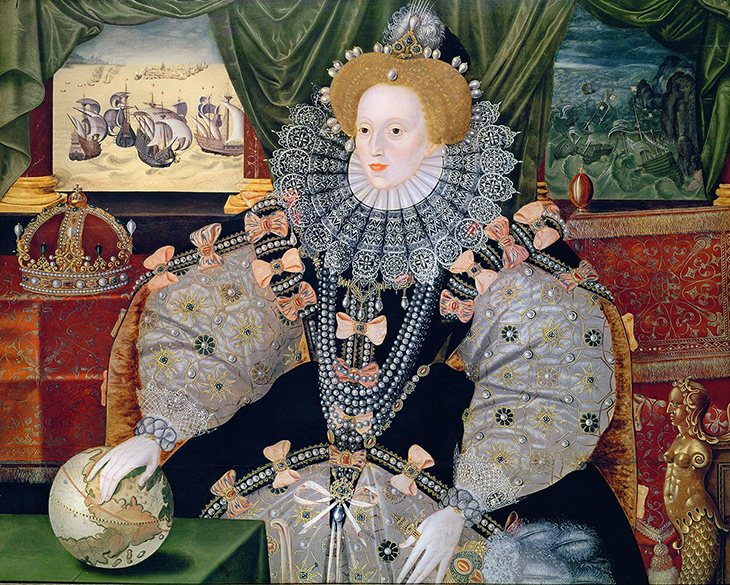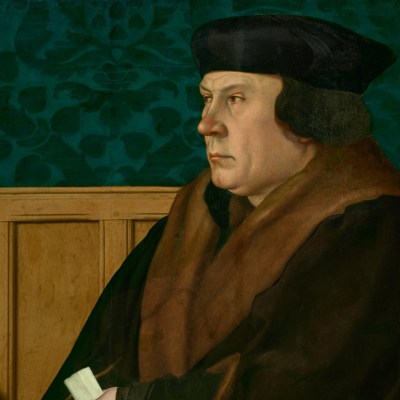The ‘scrying glass’ belonging to the Elizabethan magician and astrologer John Dee, now in the British Museum, has long been regarded as one of the most enigmatic Tudor artefacts. While it was allegedly used by Dee in the late 16th century to contact angels and demons, recent geochemical analysis published in the journal Antiquity reveals its origins in the obsidian quarries of Pachuca, Mexico. For the Aztecs who mined and created it, the mirror’s reflective properties may have been seen as deflecting bad spirits, and it was associated with the deity Tezcatlipoca, whose name translates as ‘smoking mirror’, symbolising his powers of premonition and revelation. This research adds another important layer to the object’s history, but also demonstrates the surprising extent to which Tudor England, often seen as isolated and insular, was in fact embedded in a global network of plunder, trade and diplomatic exchange.
‘Magic’ mirror of John Dee made out of obsidian (14th–16th century(?)), Aztec. British Museum, London. Photo: © The Trustees of the British Museum

The New World was one major new source of objects in the period: following colonisation by the Spanish, never-before-seen artefacts entered the European market, where their original cultural meanings were often overlaid with associations of conquest. Several portraits of Elizabeth I include fans made of Amazonian feathers, while the iconic Armada Portraits (painted to celebrate the defeat of the invading Spanish fleet in 1588) show a fan of white ostrich feathers, traded via North Africa. As Stefan Hanß has shown, besides the traditional association of feathers with royalty, the distant origins of such ostentatious objects enhanced Elizabeth’s own claims to imperial power. In the Armada Portrait the queen also wears a costume encrusted with pearls, which would have been retrieved by African and Native American pearl divers in Bermuda and the Caribbean; she is flanked by scenes showing the sinking of the Spanish fleet, and rests her hand possessively on a globe showing the Americas. Every inch of the picture reinforces the message of England’s global ambitions, and in particular the desire to challenge Spanish supremacy in the Atlantic.
Armada Portrait (1588), anonymous. Woburn Abbey

Protestant England’s diplomatic isolation from the Catholic powers of central Europe was the driving force behind many attempts to court rulers further from home, including China, Russia and the Ottoman Empire. Successful trade with lands to the East represented defiance of Spanish attempts to cut the English off from European trading partners. As Matthew Dimmock has argued, the particular desire to contact the elusive Emperor of ‘Cathay’, or China, was reflected in the special treatment of Chinese porcelain, which found its way into English collections largely via the Ottoman Empire and the Portuguese trade with India. Once in England, porcelain vessels were frequently adorned with silver-gilt engraved mounts using familiar decorative repertoires, creating hybrid objects that spoke of the aspirational ties between the two as-yet-unconnected countries.
Though frequently mangled in translation, symbols and customs associated with foreign rulers have long received enthusiastic reception at the English court. The final portrait of Henry VIII shows him dressed in a fur-lined, jewel-encrusted pelisson, a kaftan-style coat worn by the Ottoman Emperor Suleiman I and his successors. Far from a pejorative representation of a foreign culture, however, the portrait embraces Ottoman imperial symbols, perhaps ‘reclaiming’ Henry’s European notoriety as the six-times-married ‘second Turk’, or creating an alternative language of magnificence to rival the Catholic Habsburg emperors on the continent.
Arnaq and Nutaaq, Inuit from Frobisher Bay; woman in sealskin parka with baby in hood, 1585–93, John White. British Museum, London. Photo: © The Trustees of the British Museum

People as well as artefacts found their way to England, though not always of their own accord. When Martin Frobisher set out in search of a Northwest Passage to China in 1578, he kidnapped three Inuit people from Baffin Island in Canada and brought them back to be ‘displayed’ in Bristol. All three died of infection and illness within a month. Although many artists portrayed the captives, the only surviving images are the watercolour portraits by amateur artist and later Virginian colonist John White. Other visitors had more control over their representation: in late 1600 the Moroccan Ambassador Abd el-Ouahed ben Messaoud ben Mohammed Anoun arrived in London as part of a delegation sent from the King of Barbary (part of North Africa). His mission was to negotiate an alliance with England to conquer Spain, but he also found time to sit for an unknown artist, creating a portrait that combines both Islamic and Western signifiers of status.
Even the genre that the Tudors (and many scholars since) considered to be the most iconically English owes something to distant regions. The distinctive blue background found in many miniatures was usually painted with the pigments azurite or ultramarine. Azurite was relatively common, with sources found in France and Hungary, but ultramarine (literally, ‘across the seas’) was a pigment that came almost exclusively from Afghanistan. While scholars have traditionally looked to Europe for possible artistic influences on the ‘English Renaissance’ – particularly searching for evidence of classicism – the truth is that it owed something to a much wider set of networks and influences, stretching across the whole globe.


